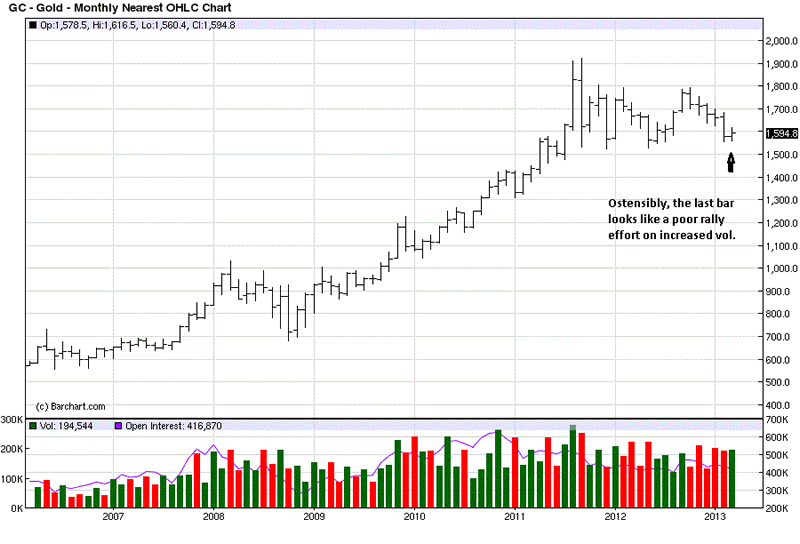
chart - marketoracle.co.uk
(Kitco News) - The second quarter kicks off next week, but the outlook for gold is expected to remain not much different than what is currently influencing the metal: underlying support from concerns in the eurozone and loose monetary policy, but not enough to push the metal into a new price range.
June gold futures fell Friday, settling at $1,595.70 an ounce on the Comex division of the New York Mercantile Exchange, and were down 0.765% on the week. Most-active May silver fell on the day and the week, settling at $28.698, down 1.3% on the week. Gold ended March up 1%, but the first quarter down 5%, while silver ended March 0.38% lower and the first quarter down 6.46%.
The U.S., U.K. and many European markets are closed Friday for Good Friday; on Monday, trade resumes in the U.S., but the U.K. and most European markets remain closed. Trade resumes there Tuesday.
In the Kitco News Gold Survey, out of 34 participants, 27 responded this week. Of those 27 participants, 17 see prices up, while six see prices down, and four see prices moving sideways or are neutral. Market participants include bullion dealers, investment banks, futures traders, money managers and technical-chart analysts.
With the situation in Cyprus still making headlines – banks just opened there on Thursday for the first time since the crisis started – several market watchers said events in the Mediterranean nation will likely continue to influence the yellow metal. However, they said, the Cyprus news hasn’t been enough to push the market above the strong resistance at $1,620 an ounce, which has acted as a ceiling for a while.
“Right now I think we’re seeing some support from the Cyprus situation, but we’re not seeing demand. Gold is still in a tight range. Still, no one is coming to us to sell, that’s for sure,” said Peter Thomas, vice president, INTL FCStone Precious Metals North America, a physical dealer.
Another dealer at a bullion bank said buying interest for gold comes in when the metal slips to the lower end of the current trading range, with demand particularly notable by physical buyers in China. That could keep prices supported and might help them tick higher, although he said he isn’t looking for any sizable gains.
George Gero, vice president with RBC Capital Markets Global Futures and a precious metals strategist, said the start of a new quarter means fund managers might have new views on how to look at their portfolios.
“Next week will be very touchy. Monday will be the first day of a new quarter, and a lot depends on what demand we may have from the funds and their participation. Right now you have poor economic data from today, the eurozone in turmoil and low interest rates. All of that would be supportive for gold, but we don’t have inflation, so I could see gold being range-bound to a little lower next week,” he said.
Gero said he’s watching fund activity, especially after the selling by investment houses of gold exchange-traded funds, as noted in 13F filings by the Securities and Exchange Commission. He said given fund selling, the first quarter might have been profit taking and with prices lower now, they could step in to buy gold again.
For next week, some analysts said, the political turmoil in Italy may grab some headlines from Cyprus as that country remains without a government. Talks between the parties will continue, but if an agreement cannot be forged, there could be another election. Bond market analysts said the tug-of-war is affecting Italian bonds, with yields for the five-year note at their highest level since October.
Frank Lesh, futures broker at FuturePath trading, said when news events affect the markets, gold finds buying interest for safe-haven reasons, but when the risk fades, prices fall. Gold has tested the upper end of the trading range, but hasn’t broken through, and that might be frustrating some market participants, he said.
“Most traders - including myself - were looking for gold to challenge the highs from late February at $1,620 (basis June), but the market failed at $1,618 and disappointed longs were liquidating. Many traders see the gold market as ‘dead money’ right now, and so far this year they are right,” he said, saying he expects the range-bound trade to continue.
Thomas said for the short term, gold prices might be trying to base. Bearish traders aren’t happy because prices won’t break and bullish aren’t happy because prices won’t rally, he said, but added: “down the line you can be sure trouble will come from somewhere.”
Looking ahead to April, the Commodity Traders Almanac said gold can be vulnerable to selling next month, continuing the seasonal decline that generally begins in January. “April tends to see tax-related selling pressure on gold prices along with other financial markets, specifically the U.S. stock markets, and more predominantly, in the technology sector...” the almanac said.
Several central banks will meet next week, with the Reserve Bank of Australia meeting on Tuesday, European Central Bank, Bank of England and Bank of Japan meeting on Thursday. Most analysts do not expect any policy changes, but eyes will be on the ECB in light of continued poor economic data from Europe and the banking stress in Cyprus.
Next week also brings the monthly U.S. employment data for March. Early forecasts call for 170,000 jobs to be created. Last month, the unemployment rate was 7.7% and 236,000 jobs were created. Last month’s jobs numbers were a surprise, so market participants will review any data revisions.
By Debbie Carlson dcarlson@kitco.com
No comments:
Post a Comment